Updated on 4/13/07 with second and third attempts
History:
Monmouth caps have been knit in England from the middle of the 15th century until the 18th century. During the early Tudor age they were given as gifts to aristocracy, but by the end of the 16th century knit caps were so common as to be regulated so that each each man must have one, and that none should be brought from overseas. This statute was meant to preserve the English wool workers, but was often ignored until repealed in 1597. Monmouth caps have been mentioned in Shakespeare, "the Welshmen did good service in garden where leeks did grow, wearing leeks in their Monmouth caps; which your Majesty know to this hour is an honourable badge of the service" in his play Henry V, Act 4, Scene 7. They are mentioned at the top of a list of recommended clothing for travelers to the Virginia Colonies in 1607. They were worn by sailors and laborers well into the 18th century and possibly beyond. For the importance of our study, they were a common, although somewhat expensive, item in the later half of the 16th century.
Having just picked back up the art of knitting in May 2003, I wanted to try a real project knitting in the round with double point needles. After looking at Kirstie Buckland's article on The Monmouth Cap, I decided to start one as an appropriate project to keep my hands busy while in Elizabethan persona. Even though most professional cappers were male in this time period, I assume that a gentlewoman could work idly on such a project for her husband. This page is not meant to be instructional, and I claim no expertise.
Extant Cap:
According to my interpretation of Kirstie Buckland's article, in the Monmouth Museum an original Monmouth cap sits dating from the sixteenth century. It is knit of coarse, thick 2 ply wool. The original hat is 59 stitches in circumference, knit entirely of a stockinette stitch of a gauge of one stitch per centimeter. The brim is a flat knit double brim about an inch tall and knit together at the edge. The sides of the hat are between 5 and 6 inches tall, and the crown is closed to about 6 stitches and finished off. Some of the other interesting features is a loop at the back of the hat and a button at the top. Pictures of the extant cap can be seen at the Isca Morrismen Tradition's page on Monmouth Caps.
Materials and Process:
- Progress: Started on 7/4/2003 and finished knitting on 7/28/2003. Added button at the top of the hat on 9/4/03. This is my first attempt.
- Materials: 1.3 skeins of gray Reynold's Icelandic Lopi yarn, 5 size 7 double point needles.
- Process: First I knit a sample with the needles I had on hand that determined my gauge as 5 stitches to the inch instead of 2.5. I cast on 126 stitches, and ran a piece of thread through the starter row so that it would be easier to add on the second layer to the brim. Then I knit in stockinette stitch the brim to about an inch in depth. I held the place of those loops with a bit of string and started back at the brim to knit up a second layer to make the hat brim doubled and flat. While this was a bit of a pain, it worked out really well. I then knit up to about 5.75 inches and then started decreasing to finish. I spread out the decreases, sometimes 2 per needle, sometimes 1, to not get uniform lines. I knit the cap until there were 3 stitches left and tied those off on the extra yarn leaving a tail at the top of the hat.
- Finishing Touches: The starter thread ends are made into a loop at the back of the cap. A longer one was used to make a buttonhole stitch around the shorter one until I reached the desired length and then I tied it off and attached it to the brim and tucked the loose ends inside the double brim. I made a small wrapped button to put at the top of the hat. Using the tail from the crown I wrapped a small wooden bead to make a button, finished off the top with a french knot and tied off the button to the top of the hat.
Lessons:
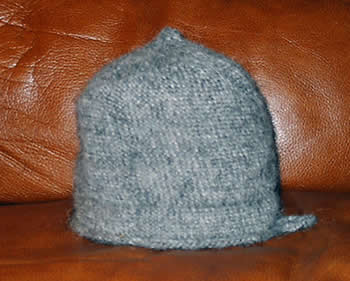 I will definitely use larger needles next time. I hear that size 10 needles should give a more accurate gauge. The gauge on original piece was 1 stitch per centimeter, or 2.5 stitches per inch, 59-60 stitches circumference. Mine ended up being more like 5 stitches per inch, 126 stitches around. I also made the crown too deep so it sticks up a bit on my head, but does have room to pull down far over ears or put a bun up inside. In my next version I will only knit it to about 5.5 inches in depth. I will also finish the top to 6 stitches and tie off, instead of 3. By going to a smaller number of stitches I inadvertently made a bit of a point at the top.
Here is a picture of my version of the Monmouth cap before the button was added to the top of the hat.
I will definitely use larger needles next time. I hear that size 10 needles should give a more accurate gauge. The gauge on original piece was 1 stitch per centimeter, or 2.5 stitches per inch, 59-60 stitches circumference. Mine ended up being more like 5 stitches per inch, 126 stitches around. I also made the crown too deep so it sticks up a bit on my head, but does have room to pull down far over ears or put a bun up inside. In my next version I will only knit it to about 5.5 inches in depth. I will also finish the top to 6 stitches and tie off, instead of 3. By going to a smaller number of stitches I inadvertently made a bit of a point at the top.
Here is a picture of my version of the Monmouth cap before the button was added to the top of the hat.
Second and Third attempts:
For my second attempt, I used white/natural Lopi wool and size 10 needles, but overestimated on the number of stitches needed and cast on 100. This made the hat too wide in the brim, but I figured it could be shrunk easily. I knit one inch for the brim, and then alternated to purling, and connected them after another inch to create the double brim of the hat. Then I started decreasing too soon and made the hat too shallow, so it would not come down over the head. The hat was then completely screwed when I accidentally tossed it in the wash, so it is now a well fulled thick wool beanie, and utterly useless. (please learn from my mistakes!)
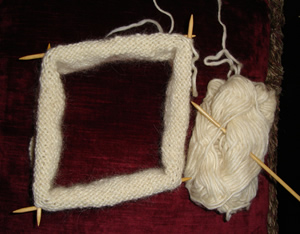
knitting in the round with double pointed needles
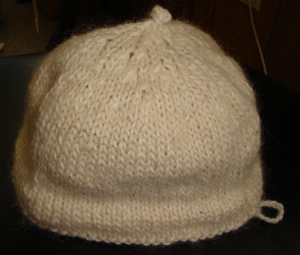
Second hat before fulling, looks good at first glance.
Just like Goldilocks, the third one turned out just right. Gray Lopi wool on size 10 needles with 80 stitches cast on to start with. Each of the later hats created on size 10 needles used less than a full skein of yarn, which is much easier to plan for. Again, I created the double brim my folding the first two inches together. The top button is actually made of nalbinding/buttonhole stitch with the last bit of yarn from the end, something easily done with a large needle.
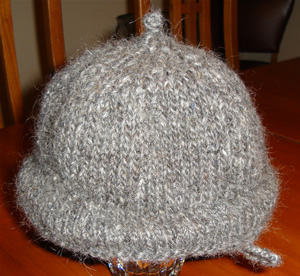
Third attempt at the Monmouth Cap
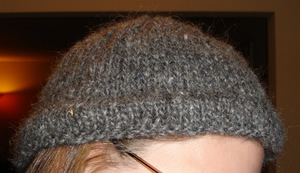
Cap as worn, fits much better than the first two tries.
Resources and Some Links to more info on Monmouth Caps:
- Buckland, Kirstie. The Monmouth Cap. 1978, Costume Society, Costume 13 (1979), 1-16. (16th-17th century) is an article on the Monmouth Cap, its history, importance and construction.
- ISCA Morrismen: http://www.isca-morrismen.com/monmouth.htm
- American Black Welsh Mountain Sheep Association Newsletter 12/99: article on Welsh Wigs
- Mention of Monmouth Caps in Shakespeare's Henry V, Act 4, Scene 7, spoke by Fluellen: http://www.aginc.net/henry_v/act4scene7.htm